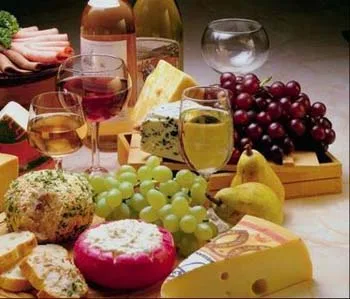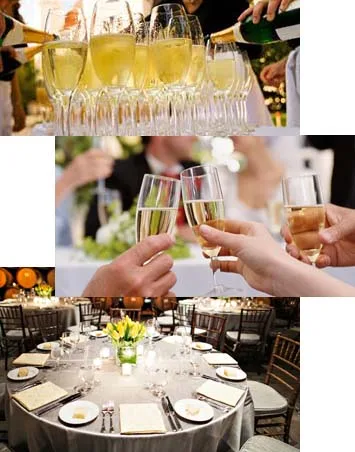In western culture, cheese is normally part of a meal and there is usually a whole course devoted to cheese. The English will normally enjoy cheeses at the end of the meal, after the dessert. This would traditionally be accompanied by a glass of Port, the famous fortified wine from Portugal. The French will serve their cheeses after the main course and before the desserts. This enables the red wine served with the main course to be continued with the cheeses.
In countries like Switzerland and the Netherlands, cheese is often served at breakfast. This would also be true of Israel. The famed Israeli breakfast covers a large range of dairy products, where there are no problems of kashrut, (mixing milk and meat.) In countries like Greece & Spain, cheese will often be served as part of the mezze or tapas at the beginning of the meal.
In Jewish culture though, we do have a festival at which it is traditional to serve dairy products. This is at Shavuot, which gives the perfect opportunity to hold a cheese and wine party.
There is something satisfyingly rustic with having a meal of freshly baked, crusty bread, with a variety of cheeses and a carafe of wine. Have you ever enjoyed the experience of ordering what is called a Ploughman’s Lunch in an English pub
The phrase, ‘cheese and wine’ rolls off the tongue. They are natural partners like Ginger Rodgers and Fred Astaire. There is a famous saying in the English wine trade: “Buy on an apple, sell on cheese.” This means an apple will show up the quality of wine as it is, faults and all, whereas cheese will make a wine more palatable. So when you are buying the wine, taste it with a slice of apple, but when you are selling it, provide cheese which will enhance the wines.
This does not mean that every wine goes with every cheese. For instance, there is regular misconception that red wine is the most natural partner to cheese, but there can be some awful clashes. Funnily enough, white wines can often go better and be more versatile.
The wine world is complicated enough. Well the cheese world is if anything even more complicated. There is such variety. Cheese may be strong flavored, fat, acidic or salty. It can be hard, soft, creamy or crumbly. It can be matured, pasteurized or unpasteurized; made from goat’s milk, cow, or sheep. President Charles de Gaulle once said: “How can anyone govern a nation that has two hundred and forty-six different kinds of cheese And he was talking only about France!
However to prepare a cheese and wine party is relatively easy to do. You will need to decide if you want to go international or Israeli. There are plenty of good quality options here too. As a simple guide, I suggest you choose at least four different types of cheese as a minimum. These could be a hard cheese, a soft cheese, a goat’s cheese and a blue cheese. This is enough to give the necessary variety.
The hard cheese may be something like Emmental, Gruyère, Cheddar or Parmesan. The best wines to match with this will be a full bodied dry white wine like an oaked aged Chardonnay or medium bodied red, possibly made from Bordeaux varieties, (Cabernet Sauvignon, Merlot etc.)
In the same way the English add milk to lessen the tannin of the strong tea they drink, the cheese will soften the tannin of the wine. Remember an older, matured cheese will be tangier with a more pronounced acidity. If the cheese is older and more pungent, the wine needs to be more mature and less tannic to avoid a clash. For this you will need older vintages. Cheeses start bland and become stronger as they age. With wine it is the opposite. Older wines are less tannic and astringent.
The goat’s cheese could be a Chèvre. The options are endless because Israel excels in this category. There some wonderful Israeli goat’s cheeses from boutique dairies. They tend to have a strong goaty character, but can go with either white or red wines. However, the classic combination for a young goat’s cheese is a varietal Sauvignon Blanc, which is very aromatic, totally dry and with a sharp, refreshing acidity. An aged goat’s cheese will go better with a well-rounded, soft style Merlot.
The soft cheese, maybe a Brie or Camembert, or something similar. If this style of cheese is too young, it will be virtually tasteless, and your guest will wonder what all the fuss was about. However if it is older, and runny, it can be so pungent as to be too strong for any wine. A balance between the creaminess and the flavor is what is desired.
This is the hardest category to find a match. A creamy, fatty cheese will make most reds seem like water. The fat in the cheese will neutralize the tannin, but an oaky and tannic red wine will taste slightly metallic when these cheeses are ripe and runny.
A Brie or Camembert would best be served alongside a lightly oaked Chardonnay with good acidity. Or alternatively, a light unoaked red wine with lots of fruit, good acidity and no tannin is the best choice. A Beaujolais style red or entry level wine from one of the larger wineries would really be ideal.
The classic blue cheeses are Stilton and Roquefort. The match made in heaven is to drink them with sweet wine because the saltiness of the cheese and sweetness play a concerto of matching flavors in your mouth. Opposites attract. A quality dessert wine, (in Israel often made from Gewurztraminer or Muscat grapes), would be the perfect partner. Alternatively a port style fortified wine will also do the trick. The salt and sweetness contrast to enhance both cheese and wine. Tasting these together should be part of any course matching food and wine to illustrate the theory does sometimes work and that ‘one plus one can equal three.’
Salt accentuates tannin so the myth that red wine goes with all cheeses is shown to be most false when a red wine is matched with a blue cheese. Note that authentic Danish Blue and the strongest Gorgonzola may just be too strong to be wine friendly.
That only leaves us with the dessert to eat after the cheeses. Obviously this is likely to be …a cheesecake! No surprises there. The best wine to enjoy with the classic New York style of cheesecake is a fortified Muscat.
Serve the cheeses at room temperature, so take them out of the fridge in advance. Decorate the cheese platter with grapes, served cold from the fridge, chutney, with some walnuts and finally a few cut vegetables, like carrots and peppers of different colors. Celery also provides a crisp, refreshing partner to cheeses. Buy some crusty baguettes, which you can cut just before people arrive, and have some healthy crackers available too.
As for wines, we have to be practical. You can’t have available every option I have mentioned. However, for the absolute minimum, you need a dry white wine, a medium bodied red wine and a dessert wine. Provide one glass for everyone and you will have prepared the easiest party you have ever hosted.
Israeli cheeses are so good and have gone through a similar quality revolution to Israeli wines. We all love cheeses, but sometimes worry about eating too much cheese for health reasons. How lucky we are that the Jewish faith has catered for us with a festival where it is compulsory!
I recommend making the most of the opportunity with a smile!



